
Kumquats, or cumquats in Australian English, are a group of small fruit-bearing trees in the flowering plant family Rutaceae. Their taxonomy is disputed. They were previously classified as forming the now-historical genus Fortunella or placed within Citrus, sensu lato. Different classifications have alternatively assigned them to anywhere from a single species, C. japonica, to numerous species representing each cultivar. Recent genomic analysis would define three pure species, Citrus hindsii, C. margarita and C. crassifolia, with C. x japonica being a hybrid of the last two.
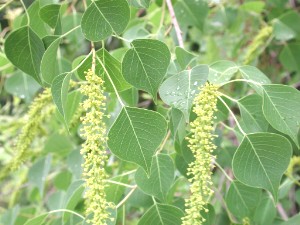
Triadica sebifera is a tree native to eastern China. It is commonly called Chinese tallow, Chinese tallowtree, Florida aspen, chicken tree, gray popcorn tree, or candleberry tree.

Citrus greening disease is a disease of citrus caused by a vector-transmitted pathogen. The causative agents are motile bacteria, Liberibacter spp. The disease is vectored and transmitted by the Asian citrus psyllid, Diaphorina citri, and the African citrus psyllid, Trioza erytreae, also known as the two-spotted citrus psyllid. It has also been shown to be graft-transmissible. Three different types of HLB are currently known: the heat-tolerant Asian form, and the heat-sensitive African and American forms. The disease was first described in 1929 and first reported in China in 1943. The African variation was first reported in 1947 in South Africa, where it is still widespread. Eventually, it affected the United States, reaching Florida in 2005. Within three years, it had spread to the majority of citrus farms. The rapid increase in this disease has threatened the citrus industry not only in Florida, but the entire US. As of 2009, 33 countries have reported HLB infection in their citrus crop.

Valeriana is a genus of flowering plants in the family Caprifoliaceae, members of which may by commonly known as valerians. It contains many species, including the garden valerian, Valeriana officinalis. Species are native to all continents except Antarctica, with centers of diversity in Eurasia and South America.

Berberis microphylla, common name box-leaved barberry and Magellan barberry, in Spanish calafate and michay and other names, is an evergreen shrub, with simple, shiny box-like leaves. The calafate is native to southern Argentina and Chile and is a symbol of Patagonia.
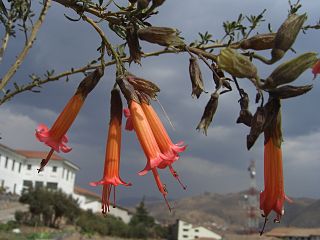
Cantua buxifolia,, known as qantu, qantus or qantuta (Quechua,) is a flowering plant found in the high valleys of the Yungas of the Andes mountains in western South America. Also known as the Peruvian magic tree, it is an evergreen shrub growing to 4 m (13 ft) tall by 2.5 m (8.2 ft) wide with small leaves and clusters of brilliant pink, narrow tubular flowers in early spring.

An orange is a fruit of various citrus species in the family Rutaceae ; it primarily refers to Citrus × sinensis, which is also called sweet orange, to distinguish it from the related Citrus × aurantium, referred to as bitter orange. The sweet orange reproduces asexually ; varieties of sweet orange arise through mutations.
Citropsis is a genus of flowering plants in the citrus family, Rutaceae. They are known generally as African cherry oranges. They are native to Africa.

Thunbergia alata, commonly called black-eyed Susan vine, is a herbaceous perennial climbing plant species in the family Acanthaceae. It is native to Eastern Africa, and has been naturalized in other parts of the world.
Citrus oxanthera, synonym Oxanthera aurantium, is a species of plant in the family Rutaceae. Sometimes referred to commonly as the orange-flowered oxanthera, it is endemic to New Caledonia.
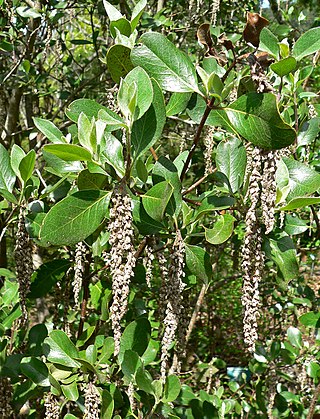
Garrya buxifolia is a species of flowering shrub, known by the common names dwarf silktassel and boxleaf silktassel, in the genus Garrya.

Pyracantha angustifolia is a species of shrub in the rose family known by the common names narrowleaf firethorn, slender firethorn and woolly firethorn. The flowers are white and produce small round pomes and can be orange to red in color. These fruits are astringent and bitter, making them inedible for humans, but they are a food source for birds. The leaves, fruit and seeds contain hydrogen cyanide, the source of the bitter taste. The stems and branches have sharp spines. This shrub is cultivated and grown in yards and gardens as an ornamental plant. It can be used to make hedges for home security. This species is native to China but has been introduced to North America and Australia. It is an invasive species in Hawaii and in other areas.
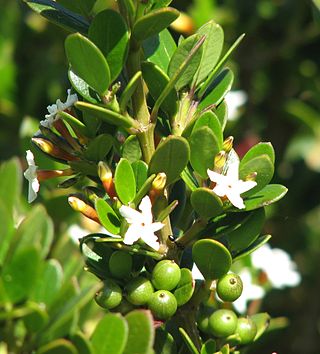
Alyxia buxifolia, otherwise known as the sea box or dysentery bush, is a species of evergreen shrub in the family Apocynaceae.

Riverside, California, was founded in 1870, and named for its location beside the Santa Ana River. It became the county seat when Riverside County, California, was established in 1893.

Bossiaea buxifolia, commonly known as matted bossiaea, is a species of flowering plant in the family Fabaceae and is endemic to south-eastern Australia. It is a prostrate to weakly erect shrub with elliptic to egg-shaped or almost round leaves and yellow, red and purplish flowers.

Rhamnus alaternus is a species of flowering plant in the buckthorn family Rhamnaceae, known by the common names Italian buckthorn or Mediterranean buckthorn. It is a hardy medium-sized evergreen shrub with fragrant flowers.

Kalmia buxifolia is a species of flowering plant in the family Ericaceae known by the common name sandmyrtle, or sand-myrtle. It is native to the mid-Atlantic and southeastern United States, where it has a disjunct distribution, occurring in three separate areas. It is known from the Pine Barrens of New Jersey, the Coastal Plain of the Carolinas, and the southeastern Blue Ridge Mountains.

Atalantia is a genus of flowering plants in the citrus family, the Rutaceae.
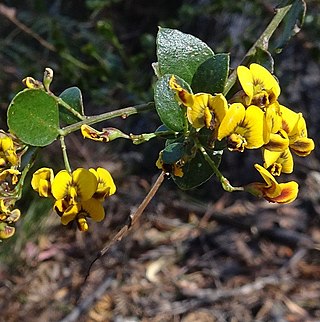
Daviesia buxifolia, commonly known as box-leaf bitter-pea, is a species of flowering plant in the family Fabaceae and is endemic to south-eastern continental Australia. It is an open shrub with egg-shaped to round phyllodes and yellow or yellowish-orange and maroon-brown flowers.
















